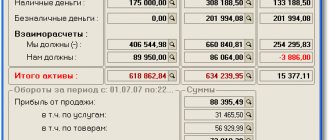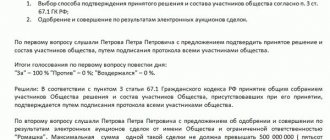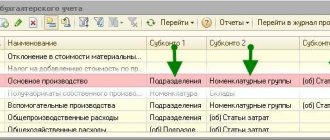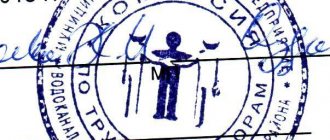Management reporting is common among Russian businesses along with financial and accounting reporting. What are its most notable features? All businesses are required by law to maintain accounting records and prepare reports. However, standard accounting reports do not contain all the information needed to effectively manage a business. Therefore, in most enterprises, in addition to accounting, management reporting is also prepared. Let's consider how management reporting is prepared and its
Income and Expense Report
The income and expense report allows you to analyze the volume of cash flows, revenue from sales of products and costs of their production and sale, and calculate coefficients characterizing the business activity and financial stability of the enterprise.
First, the enterprise prepares a planning document on future income and expenses, and based on it, an actual management report. On its basis, planned and actual indicators are analyzed.
An example of an income and expense report is presented in table. 5.
Table 5
Management report on income and expenses
When presenting management reports to management, you must be prepared to answer questions. For example, if there is no income - “why?” In this case, it is necessary to find out why the funds were not received - there were no shipments, the customer delayed payment, etc.
If the expense portion of the report has changed significantly, you may have to prepare a more detailed report for certain items.
An analysis of the income and expense report will allow you to understand in advance that in a certain period there will not be enough money in the account, for example, for advances to suppliers. Then management will have the opportunity to quickly respond to the situation, for example, agree to postpone the terms of the advance.
Naturally, such reports are constantly adjusted depending on changes in planned payments.
Cash flow statement
The cash flow statement (CFS) contains information about cash flows (according to the current account and/or cash register), reflecting both planned and actual receipts and expenditures of funds.
The structure is similar to the cash flow budget (CFB), the distinctive feature is the presence of actual indicators characterizing the execution of the budget.
ODDS allows you to assess the financial capabilities of an enterprise, monitor the availability of funds in the account and in the cash register of the enterprise, balance the receipts and expenditures of funds, and therefore control the liquidity and solvency of the enterprise.
ODDS, like BDDS, includes cash flows from current investment and financial transactions.
Current cash flows are revenues from the sale of products, rental payments, expenses for paying for the services of suppliers and contractors, wages for employees of the enterprise, tax payments, etc.
Investment cash flows are transactions associated with the acquisition, creation or disposal of non-current assets, such as costs for development and technological work, provision of loans, payments in connection with the acquisition of shares, etc.
Cash flows from financial transactions include proceeds from operations related to attracting financing (cash deposits, payments in connection with the repurchase of shares, payment of dividends, repayment of bills, etc.).
In order to effectively plan the expenditure and receipt of funds, it is necessary to conduct a plan-factual analysis, especially in a crisis situation, when payment discipline worsens and the enterprise may not have enough money to make payments.
Management ODDS increases the efficiency of planning and budgeting in general.
An example of a cash flow statement is presented in table. 6.
Table 6
Cash flow statement for July 2020, thousand rubles.
The first thing a manager or other end user of the ODDS will pay attention to is the negative value of the cash flow indicator.
For your information
Cash flow is a calculated indicator for each type of cash flow (current, financial and investment activities), representing the difference between cash receipts and expenditures.
A negative cash flow value indicates that cash receipts are lower than expenditures. And if the business had no cash balance from the previous month, it would not be able to make payments.
In the example, ODDS is presented broken down by manufactured products and separate divisions (Moscow and St. Petersburg). Management may require a more detailed breakdown, for example, if plans differ significantly from actuals.
Based on the cash flow, for example, for a month, cash flows for the next month are predicted, taking into account expected receipts.
Analysis of actual cash expenditures for a month allows you to classify expenses from the point of view of consistency and commitment, to form a certain “constant”, i.e., the amount of cash expenditure that is necessary monthly.
Based on the payment registers and payment calendars in terms of receipts of advances and final payments from customers, the revenue part of the ODDS is formed.
Such cash flow planning ensures efficient cash flow management.
Note!
Plan-actual analysis of the cash balance allows you to set a limit on the cash balance at the end of the month in order to ensure the solvency of the enterprise at the beginning of the next reporting month and in the event of insolvency of counterparties.
The procedure for preparing management reporting - 6 main stages
Management reporting is prepared in different ways. Several years ago I worked in a company where a whole staff of accountants and financial specialists participated in the preparation of reporting documents.
The report was detailed and detailed, which allowed management to conduct comprehensive analytics and timely adjust the operation of the enterprise, if necessary.
In another company where I also worked, the report was handled by one accountant using 1C, and he entered all the data into the program manually. There was little sense in such a report.
To create a competent and useful report, use a ready-made algorithm. The scheme does not pretend to be the ultimate truth - when creating your own report, take into account the specifics of the enterprise and its scale.
Stage 1. Setting goals and objectives
First we need a clear understanding of the problems that need to be solved using management reporting. It is useful for the CEO of a company to have the necessary information at least every week. And if the enterprise is a time of change and the introduction of new technologies and methods, then more often.
The goals in each case are individual: control of income and expenses, analysis of product costs, assessment of the efficiency of departments, tracking the dynamics of receivables and payables.
The form in which the MA is provided to management is also important. It is more convenient to use tables and graphs than text files. The more detailed the documents, the better.
But remember - you cannot embrace the immensity. You need to be able to structure information by income and expense groups, by types of clients, by departments, and summarize interim results.
The frequency of reporting is regulated by management itself. If the director requires a report to be prepared weekly, it will be produced weekly. The situation is similar with detailing.
Stage 2. Determining the circle of officials who need management reporting
This is a necessary stage for the effective organization of the process of preparing the MA. It is determined to whom exactly and what kind of reporting is provided.
It is also important not to forget about those responsible for preparing the reports. Often managers or leading specialists of the relevant departments are appointed responsible. They are responsible for both the content of reports and the timing of their preparation and submission.
Large companies also organize special units for the preparation of management reporting.
Stage 3. Determining the information that should be presented in management reporting
What information will be contained in the report depends on the purpose of compiling this document. As a rule, it includes the most significant data that reflects the real economic and financial situation at the enterprise.
It will be good if the logical relationship of the indicators is taken into account for the convenience of the process of analyzing the RO and conclusions. Sometimes managers ask those who generate reports to immediately formulate key conclusions .
Stage 4. Determining the possibility of using information generated in accounting systems
Evaluate what information we need for management purposes is already contained in the company’s accounting information systems. We are talking about accounting, financial, tax and other accounting systems that have already been established and are successfully functioning in the enterprise.
If this is the case, then you can and should try to use it, which can significantly simplify the task and save you from “double work.”
Reporting should be regular, clear and structured
Stage 5. Development of regulations for management reporting
Regulations for the preparation of reports are definitely needed - who will provide them, in what form and within what time frame. Document these agreements.
Let each head of the FRC (financial responsibility center) monitor the execution of the process.
Stage 6. Development of tools for collecting, generating and processing management reporting information
Instruct IT specialists to develop programs (or file templates) in which responsible persons will generate reports.
But don't forget about the main principles:
- the costs of automation must be recouped by the benefits of its use;
- a bad program - worse than a thoughtfully designed Excel spreadsheet system.
If the company does not have its own IT specialists, use the help of third-party companies. There is information about them in the next section.
— Lyudmila Prokofievna , you turned out to be amazingly perspicacious. You are just looking into the distance! I'm currently working on my report, and it's getting better and better right before my eyes!
- I’m glad for you, Comrade Novoseltsev...
From the film “Office Romance”
Income statement
This is perhaps the most important management report. It reflects information about the actual profit/loss of the enterprise.
The form of the financial results report (form No. 2) of the financial statements is approved by Order of the Ministry of Finance of Russia dated No. 66n (as amended) “On the forms of financial statements of organizations” and has a fairly detailed form.
In a management report, it is permissible to both group some lines of the report and, conversely, provide a more detailed breakdown (primarily this concerns the company’s expenses).
The final recipients of the document can also request detailed information on revenue (for example, broken down by type of product).
A fragment of the management report on financial results is in table. 1.
Table 1
Fragment of the management report on financial results, thousand rubles.
The main thing we see from this report is the positive financial result of the enterprise: revenue exceeds the costs the enterprise incurred to produce and sell products.
However, every company constantly strives to increase profits. To do this, as a rule:
- increase the selling price per unit of production (which, as a consequence, increases the amount of revenue);
- reduce the cost of sales (with a constant amount of revenue, this increases profit, including profit per unit of production).
When planning financial results based on management reporting, actual and planned sales volumes are taken into account. Such planning is quite conditional, since the cost of sales includes both fixed and variable costs, and the former practically do not change with an increase or decrease in sales volume.
We will carry out preliminary calculations to draw up a planned report on financial results.
We know that revenue in the amount of 68,074 thousand rubles. received from sales of 257 units. products at a price of RUB 264,880.00. per unit (the analyzed enterprise produces one type of product).
In the next reporting period, it is planned to sell 294 units.
Thus, the planned revenue will be 77,875 thousand rubles. (RUB 264,880.00 × 294 pcs.) at a cost of RUB 64,767 thousand. (RUB 220,295.70 × 294 pcs.).
Forecast report on financial results - in table. 2.
table 2
Forecast report on financial results, thousand rubles.
With such planning, profitability indicators (products, enterprise, sales, etc.) remain unchanged, because forecasting takes into account only fluctuations in sales volume.
Let's calculate the main profitability indicators that characterize the profitability of the enterprise and the economic feasibility of its activities.
Profitability of core activities (R1) is the ratio of profit before tax to revenue from product sales. This ratio shows what part profit is in revenue.
Conventionally, the normative value is considered to be 10–15%.
In our case, R1 = 10,078 / 68,074 × 100% = 11,728 / 77,875 × 100% = 15%.
The higher the profit margin in relation to revenue, the more profitable the enterprise is considered.
Product profitability (R2) is the ratio of net profit to total cost. This indicator is very important for analyzing the efficiency of activities: it shows how profitable the products produced are, how much profit the enterprise received from the total costs of its production.
In our case, R2 = 8062 / 56,616 × 100% = 9382 / 64,767 × 100% = 15%.
For your information
At the stage of analyzing management reporting and planning activities in the short or long term, it is possible to identify problem areas, such as high enterprise costs for production, low revenue, etc.
Based on the results of the analysis, they formulate a policy for the further development of the enterprise, make decisions, for example, on abandoning the production of any type of product, on expanding the sales market, optimizing costs, increasing/lowering the retail price, etc.
What does management reporting include - overview of the main points
Now about what is included in the UO. Unlike financial and tax accounting, which are strictly regulated by law, management reporting is prepared in free form and meets the needs of the management of a particular company and meets budgeting objectives.
For this reason, there are many options for such documents. However, there are points that should be included in the report without fail, so that management can analyze the current economic situation in the company and objectively assess the prospects.
Point 1. Operating reports
Operational activities are the main work of a company aimed at generating profit. This includes the production of products, the provision of services and any other core activity through which the company earns money.
This report includes the following data:
- on the production of goods;
- on the acquisition of inventory items;
- on the purchase of raw materials, consumables and components;
- on stocks of finished products in warehouses;
- about cash flow;
- about accounts receivable.
The operating instructions are a document that reflects the current state of affairs.
Point 2. Reports on investment activities
Investing is part of a company's financial activities. Even a small enterprise invests in the development and expansion of production.
The MA on investments reflects the following parameters:
- movement of fixed assets;
- movement of the company's intangible assets;
- long-term cash deposits;
- planned capital investments;
- data on the implementation of investment projects.
Point 3: Financial statements
Financial activities include short-term investments, raising debt and equity capital, lending and cash management (company cash). All these aspects are reflected in the financial LO.
Point 4. Reports on sales or services provided
The sales report is prepared by the enterprise sales service for the head of the sales department, commercial and general directors. It shows the quantity of products sold and at what prices.
Sometimes additional items are included - shipment dynamics, information about inventories in warehouses, sales costs, information about accounts receivable.
Point 5. Procurement reports
The purchasing report includes information about the purchases of raw materials, consumables, equipment, tools and other production assets. A separate document of this kind is needed at large production facilities where a variety of material assets are used for work.
For clarity, let’s put the basic types of educational institutions in a table:
Management reporting should reflect the key performance indicators of the company
Natalya Gazizova , head of representative office, Moscow
In order to exclude a creative approach to the preparation of company management reporting in the work of financial services, the manager must clearly highlight the main indicators of the company's activities. At the same time, this data should be informative and allow one to monitor the results of work and make forecasts. In our company, we include the following indicators:
- volume of receivables and outstanding invoices (DSO, English: daily sales outstanding - indicator of unpaid sales);
- the ratio of sales volumes to current customers and new ones for the reporting period;
- gross margin (cross margin);
- analysis of company costs (run-rate analysis);
- the contribution of each area of activity (each type of product) to the company’s profit (contribution);
- capital expenditures.
Due to the fact that we are a consulting and project-oriented firm, it is important for us to also consider the average consultant hourly rate and implementation (this indicator allows us to determine the degree of employment of our consultants in projects).
Contents of management reporting
What may be contained in the documents that make up the type of reporting under consideration? The fact is that sources of information of the corresponding type can be presented in a large number of varieties. As a rule, certain documents are adapted for specific managers. Reporting is called management reporting mainly due to the fact that it is intended specifically for managers.
The management structure of modern organizations, as a rule, includes the positions of a general director, as well as his deputies. These could be: a deputy for production, for sales, or, for example, for financial issues. In the first case, internal management reporting may include data relating to:
- the cost of manufactured products or services (in relation to specific types of products);
- characteristics of work in progress, release of goods and services in relation to orders from specific customers;
- the volume of production of products that are sent to the warehouse;
- stocks of raw materials, materials or components that are used in the production of goods.
If reporting is submitted to the Deputy Director of Sales, then its structure may include:
- information about the sales structure in relation to specific types of goods and services, with specific customers;
- data on the dynamics of product shipments;
- information about stocks in the warehouse;
- data on the cost of selling goods or delivering to consumers;
- planned indicators regarding the receipt of goods at the warehouse;
- information on accounts receivable for sold items.
If reporting is subject to submission to the Deputy Director for Finance, then it may contain:
- information on the execution of the enterprise budget;
- information on costs associated with business activities;
- figures reflecting the cost of goods or services produced;
- profit and loss data;
The reporting may also contain information about accounts receivable and the company’s own debts on loans and other obligations.
https://youtu.be/vkGMyOi1fZw
Generation of management reporting using outsourcing
If you decide to start using management reporting in your organization, but don’t understand where to start, then you should choose specialists in this field and entrust this task to them. Here are the main signs that characterize real professionals in this field.
- Efficiency of reporting
In cases where reporting documentation is provided slowly and late, the data becomes irrelevant. Such reports have no value at all, because it is impossible to make the right decision based on data that has lost its relevance.
In cases where reporting arrives much later than the request from the manager, it has no value - think about implementing a new system from another outsourcing company.
- Reliability of information
In cases where it is impossible to confirm the data, and employees cannot explain where certain digital data come from, it is worth drawing the conclusion that the system is far from perfect or they do not know how to use it competently. In any case, those who implemented such a management reporting system are to blame.
- Reporting is provided in a simple and understandable format
Most often, managers do not have the time to devote themselves to understanding complex tables and graphs, as well as searching for important information among unnecessary data. Therefore, management reporting should be clear, concise and structured. However, it is worth remembering that excessive detail is just as bad as unnecessary information. Thus, it is necessary to find a middle ground.
https://youtu.be/LzREGdN7c8Q
Algorithm for generating reports
Let's consider how management reporting can be generated in practice. Among Russian experts, a popular algorithm involves solving the problem under consideration in the following stages.
The first step is to find out what type of reporting information the general director, his deputies and owners want to see, and with what frequency. Some may prefer to see the numbers weekly, while others may want to see key indicators once a month. It is also advisable for the future report preparer to find out at the very beginning of interaction with management what type of data is most likely to be a priority and what type of data will be secondary.
The next step is communication with the accountant to determine the algorithm, within the framework of which the person involved in solving the problem under consideration will request the necessary numbers. The reporting preparer can also interact with other employees of the company in those areas where indicators that are significant for the necessary documents are formed. The enterprise must develop a management reporting system in which all competent employees will participate.
The next step is to create document forms in which, on the one hand, the numbers will be recorded and, on the other, interpreted. At the same time, the person responsible for reporting may be faced with the need to create different forms of documents adapted for a specific addressee - the general director, his deputies, owners.
The next steps will be related to the actual generation of reports. If the enterprise is small, then, in principle, the person involved in solving the problem in question can try to collect the necessary numbers himself. But it is likely that he will need the help of his work colleagues. In this case, the practical stages associated with collecting information may be preceded by some meetings at which the person will tell other employees about the basics of management reporting, the purpose for which the relevant documents are generated and why this is important for the company. The solution to this problem can be facilitated by the management of the company by issuing local legal acts that require individual employees to assist in the work of the person responsible for reporting.
What difficulties may be associated with preparing management reporting?
Experts in the field of business and management believe that the main problem in the preparation of management reporting is the lack of sufficient loyalty to such documentation on the part of both the organization’s employees and, in some cases, on the part of business managers and owners. This is often due to the reluctance to spend time on generating additional reports, because companies already have obligations to provide certain official documents to government agencies, which also takes a lot of time and effort. Therefore, it happens that management reporting is simply not perceived as documentation that is really worth attention. Moreover, not only the director, but also the business owners themselves, as mentioned above, can think this way. The fact is that management often perceives such reporting as another method for misleading management representatives, especially when there is a need to divert attention from any unsuccessful production indicators.
What could be the solution to this problem? Typically, analysts advise starting at the management level. Top managers should be primarily interested in the preparation of management reporting, because they are the ones who can formulate all the necessary local legal acts, according to which other employees will have to assist in the formation of the relevant documents.
Another difficulty in solving this problem lies in the need to continuously develop new approaches to interpreting the figures contained in the report. There is a conditionality of this fact due to changes in the structure of business production. When working with accounting and financial statements, there is no need to interpret the numbers, which means you can use standardized forms that record the relevant indicators.
Management reporting is designed to solve other problems. First of all, these reports are needed by the company itself, and not by any government bodies (unlike accounting and financial reporting forms). Even when the interpretation of the figures contained in management reporting, given the structure of production in a certain period, played a positive role, there is no guarantee that it will be just as useful, provided that the characteristics of certain business processes have changed.
If any changes occur in the production area, the compiler of reporting documentation will be forced to improve approaches to interpreting digital data. This is a rather lengthy process, because the compiler will most likely have to spend not only his time, but also the personal time of colleagues, to whom he can turn for advice, opinion, or for some auxiliary indicators that reflect the results of the enterprise.
An excellent solution to this problem is established communications between colleagues (for example, meetings where current indicators are reviewed and measures are developed to improve them, including through the introduction of new reporting methods, such as management).
- Internal communications in a company: dispelling myths
Accounts receivable and payable report
The report on receivables and payables can be combined into one management document or divided into two independent documents. It allows you to assess the solvency of an enterprise and track debt turnover using relative ratios.
The very fact of the formation of receivables and payables is inevitable due to the temporary gap between payments and the transfer of finished products.
For your information
Accounts receivable are funds owed to the company by debtors; Accounts payable are funds that a company owes to its creditors.
A report on accounts receivable and payable is compiled as of a specific date, and the final recipient sees information about the status of settlements with counterparties and can quickly monitor the fulfillment of obligations.
An example of a management report on receivables and payables of an enterprise is in table. 9.
Table 9
Report on receivables and payables on
Analyzing the report data, the manager will see that the company advanced 80% to Norman LLC (RUB 880,000.00). The products have been shipped in full. But the company has not yet paid off completely - a debt in the amount of 220,000.00 rubles.
At the same time, Beta LLC made an advance (50%) in the amount of 5,500.00 thousand rubles, the products were shipped in full. But the company has not received the final payment of 50%.
As a rule, contracts with counterparties specify the terms of delivery and the time interval between delivery and final payment (for example, final payment is made within five working days from the date of acceptance of the delivered products by the buyer). For violation of payment deadlines, sanctions are expected (for example, a penalty in the amount of 0.1% of the amount of the delayed payment for each day of delay).
Therefore, in the event of claims from creditors, the company will be forced not only to make a final settlement, but also to pay penalties, and these are additional unforeseen costs.
Report on the actual cost of production
One of the main tasks of each enterprise is to form a market price such that it covers the costs of producing the products sold, while being competitive, consistent with the quality of the products and ensuring market demand.
After a market or contract fixed price has been formed, it is necessary to try to maintain the cost - if the cost exceeds the price, the enterprise will not make a profit. You can control the situation using a management report on the actual cost of production (Table 7).
Table 7
Report on the actual cost of production, rub.
This report reflects deviations of planned costing indicators from actual ones. And if they are significant, additional analysis is needed to determine the reasons.
As a rule, at this stage of compiling management reporting, they also establish a group of costs that have the largest share in the cost structure and, on the basis of this, formulate a cost reduction policy to increase product profitability. For example, in order to reduce material costs, they renegotiate contracts with suppliers on more favorable terms or look for new ones; in order to reduce the wage fund, they reduce the number of workers, attract third-party organizations to carry out work, etc.
Taking into account measures to optimize the cost structure, an updated structure is planned for the next reporting period.
Let's consider an example of drawing up a planned calculation of the cost of production, taking into account the growth in volumes while maintaining general business expenses (as a constant component of the cost structure, regardless of fluctuations in volume) at the same level (Table 8).
Actual general business expenses per unit of production (see Table 7) - 41,642.70 rubles. with a sales volume of 257 units. products in the reporting period. Consequently, the total amount of general business expenses is RUB 10,702,173.90. (RUB 41,642.70 × 257 pcs.).
The planned sales volume for the next reporting period is 294 units. Let us divide the total amount of general business expenses (RUB 10,702,173.90) by the planned volume, and we obtain specific general business expenses per unit of production (RUB 36,401.95).
The remaining cost items are accepted for the planning period unchanged according to the actual data of the cost report.
Table 8
Planning the cost structure taking into account the proposed measures, rub.
We left unchanged all cost items included in the cost price, with the exception of general business expenses, which conditionally do not change depending on the growth of sales volumes.
Thanks to optimization, the planned specific profit per unit of production, while maintaining the retail price at the same level, will be increased by 5,240.75 rubles, by the total forecast sales volume - 1,540,780.50 rubles.
If no measures are planned to optimize costs, the planned cost structure, as a rule, includes actual data for the previous period.
Organization of management accounting
All types of reporting that accompany management accounting are sources of information for analysis. In synthesis with the reports used in budgeting, they are the basis for:
- decision making,
- assessing the financial condition of the company, its solvency and liquidity,
- forecasting development dynamics in the future,
- investment attractiveness,
- identifying bottlenecks and developing measures to eliminate them,
- adjustments to plans,
- monitoring the execution of plans,
- cost optimization,
- rational distribution of income,
- preventing cash gaps (current shortage of funds),
- system resource management,
- optimizing the amount of inventory,
- determining the sufficiency of own funds for the implementation of investment projects,
- the need to attract borrowed funds for the successful implementation of new technologies and the purchase of fixed assets;
- identifying promising areas of development,
- analysis of deviations of actual indicators from planned ones in order to monitor the execution of budgets and adjust them to achieve set goals;
- implementation of measures aimed at improving financial performance results in general.
The main goal of management accounting is to find reserves to improve the efficiency of the enterprise. All information obtained through automation of management accounting should be in demand by managers at all levels, be of economic interest to them and be the basis for making rational decisions that contribute to the further positive development of the company.
Shareholder reporting
Experts in the field of business management recommend paying special attention to the preparation of reports intended for company shareholders. What are the specifics of relevant communications?
The main feature here is that the company's shareholders may not take any direct part in the management of the company. It's often the case that the only area they're interested in is pure profit numbers. Detailing management decisions in reports provided to company shareholders is in some cases inappropriate. However, since the owners of the company are the ones who make key decisions regarding the appointment of top managers, the reports will be able to reflect information characterizing the performance of the general director and his deputies.
Types of management reporting
All types of management reporting must eliminate uncertainty and provide an objective picture, which is necessary for the performance of management functions. Therefore, for example, automation of management accounting is a system of related indicators that have a full set of characteristics necessary to justify decisions based on objective data.
All types of management reporting have standard forms (in accordance with the approved Accounting Policies), but they can be detailed depending on the company’s needs for data decoding. For example, to determine categories of potential buyers or priority groups of goods, a special report can be used that involves generalizing the range of goods and target buyers according to a number of characteristics.
What is management accounting
Management accounting can be called a link between the past, present and future. This part of the enterprise information system is responsible for reviewing information in the analytical aspects required by top management.
There are no uniform requirements for building a management accounting system. There are only recommendations based on the experience of entrepreneurs that can and should be adapted to the needs and scale of a particular business.
The opinions of scientists regarding what management accounting is are also divided. But most experts agree that management accounting is not formalized reporting, which is valuable in itself. This is one of the means to achieve success in business.
Progressive companies are constantly striving to improve profitability. One way is to use the Shewhart-Deming cycle and its derivatives.
It is obvious that without established algorithms for working with information, none of the stages of the decision-making cycle will be effective.
Using management accounting, management evaluates the relationship between decisions made (both global and local) and results for the company.
Properly organized management accounting allows you to see an objective picture of whether the enterprise is approaching its goal. Local processes sometimes seem optimized, but this does not have a positive effect on the overall result of the activity. This means that management accounting is a tool for getting rid of illusions.
We recommend. BIT.FINANCE. Management Accounting. A comprehensive solution based on 1C:Enterprise 8 for organizing management accounting for an enterprise of any size!
Automation of management accounting
Management accounting programs allow you to solve problems of process automation, control and reporting. Universal and effective solutions are the “WA: Financier” line of software products. They can be used at enterprises with different specifics and volumes of document flow at enterprises in Moscow and other regions of Russia. They are effective for use in organizations with a dedicated financial service, as well as in companies that operate with aggregated data received from external systems.
Frequency of management reporting
How often should management reporting be prepared? It is desirable that information reflecting the specified areas of activity of the enterprise should not be out of date by more than a week. In some cases, a particular enterprise may have identified key indicators that will need to be updated more often. Similarly, management can record secondary indicators that do not require much time to compile, and therefore such information can be provided much less frequently.
Methodological approaches
Management accounting tools can be classified according to various criteria, depending on methodological approaches.
1. Depending on the volume of information processed, the formation of management accounting can be:
- Systematized. Conducted on a regular basis, it includes measurement, assessment and control of costs for all types of processes (supply, production, sales). All costs are grouped by items and elements, sources and media. An internal report is being compiled, the content, timing and frequency of provision of which satisfy internal users and allow an assessment of the activities of the enterprise as a whole and individual structural divisions.
- Differentiated. The content is selective and depends on the tasks.
2. Depending on the goals and objectives of management, the formation of management accounting can be:
- Strategic. Focuses on determining the company’s development prospects and providing information to top management.
- Operational. Ensures achievement of goals in the short term
- Production. The task is to provide information about the cost of production, the amount of profit, and the cost of inventory.
3.Depending on methodological approaches to organizing management accounting, the following can be used:
- Integrated (monistic) system. The management system is interconnected with the financial system. The chart of accounts in the management system is linked to financial accounts.
- Autonomous (dualistic) system It is assumed that management and financial systems will be created separately. The chart of accounts of the management system is not linked to the financial one. The process focuses only on management needs.
4. In terms of the scope of activities and organizational structure of enterprises, the management system can be:
- Complete system. This type applies to the activities of the enterprise as a whole and its individual structural divisions.
- A sufficient system (with a limited set of indicators). The essence of this type is that it is carried out only for individual objects or their group.
5. For efficiency and data control, accounting can be used:
- Actual data. The method of attributing actually consumed resources to costs, calculating the actual cost and financial results from product sales is used.
- Regulatory data. In this case, it is assumed that certain cost norms will be developed and accounting will also be carried out according to norms (standards) with deviations highlighted.
6. Based on the completeness of costs, the following types can be distinguished:
- Full costs. Cost is calculated by including all costs
- Marginal. The reduced cost is calculated.
Common features and differences between management and financial reporting
All enterprises in Moscow and other cities of Russia must keep financial records, since they are regulated by the legislation of the Russian Federation. Its purpose is to provide information for external users, including government agencies (for example, the tax inspectorate). The purpose of introducing management accounting tools is to provide complete and objective information for internal users, which can facilitate the adoption of effective management decisions. Internal information may be the subject of a trade secret and its distribution outside the company may be accompanied by sanctions against violators. Financial statements are the basis for analyzing the financial viability of a company, used by investors, creditors or other parties interested in investing capital. The formation of management accounting is primarily the basis for effective management, since it displays objective information about the current financial condition of the enterprise. With its help, operational decisions can be made in order to respond in a timely manner to changes in the external situation or adjust paths that contribute to the achievement of strategic goals.
Financial reporting forms are standardized, therefore understandable to external users and comparable in terms of indicators. Forms of internal management reporting can be varied and are approved in accordance with company regulations. But in turn, they must also be unified in order for performance indicators to be comparable across the functioning of individual structural units.
Management and financial systems are interconnected and have commonality:
- Unified objects;
- General approach to defining goals and monitoring their achievement;
- Similar principles if an identical chart of accounts is used;
- One-time input of primary data;
- The information base is used for analysis and management decision-making;
- Application of similar techniques.
Many business transactions in the financial and management systems are displayed identically, others still require a specific approach, depending on the company policy applied to the management system. These two types of accounting also have significant differences; they relate to the following aspects:
- Periodicity. In management, reporting periods are regulated by internal Regulations, in financial – by state legislation.
- Nature of indicators. In financial terms, all indicators are measured in monetary terms; in managerial terms, the range of units of measurement is wider; in addition to cost criteria, natural values and qualitative indicators can be used.
- Level of detail. Management reporting presents analytical information in more detail.
- Method of grouping data. The two systems may use different principles for grouping information.
- The degree of accuracy of the information. In management, tolerances are possible, that is, certain errors, which are unacceptable in finance.
Budgeting in management accounting
The budgeting process allows you to systematize enterprise management, determine goals and ways to achieve them, thanks to the planning and specification of indicators for all areas of activity and structural divisions. The organization of budgeting is carried out by centers of financial responsibility, by distributing functions, powers and responsibilities, determining the area of responsibility, and forming certain types of plans with maximum detail. This approach allows:
- achieve planned goals;
- optimize costs;
- rational use of resources;
- optimally distribute funds;
- improve the performance of business activities in general.
What is management reporting and what is it used for?
Enterprise management is a continuous process, the essence of which is influencing an object in order to stabilize, control or change it in accordance with business objectives. Another management function is the rational use of the company’s workforce and resources to increase profitability.
To keep a business efficient and competitive, managers must make certain decisions all the time. These decisions are based on current information about the affairs of the enterprise. This is exactly the information that management reporting (MA) provides to management.
Management reporting is a company’s internal control tool and a way to assess its economic prospects.
Unlike financial reporting, no one obliges you to prepare management reporting. But managers need it to effectively manage their business. The MA contains information about all structural divisions of the enterprise.
It can be argued that a competent manager is able to evaluate economic indicators based on accounting records. This is partly true, but accounting does not reveal all the nuances of the enterprise.
It is difficult to understand from accounting reports which products are in high demand and which are the opposite. Management accounting shows a more clear picture.
Example
expanded its product range last year. With the help of management reporting, which the executive director proposed to introduce at the enterprise, management found out that the products “Family Dumplings” and “Village Sausage” are in greatest demand. We decided to increase the production of these items.
The MA also showed that purchasing packaging materials from suppliers is less profitable than making them yourself. The director decided to open a new workshop for the production of his own packaging.
Reporting is needed by economical, far-sighted and prudent owners who want to make a profit not only by increasing production volumes, but also by increasing labor productivity, as well as reducing unnecessary expenses. This is an integral part of competent budgeting in an enterprise.
Who is the customer of management reporting? TOP managers and line managers - production directors, financial directors, sales managers, etc.
To compile a document, various forms are used, most often tables, graphs, and diagrams.
The information should be:
- reliable - reflect real processes without any additions or manipulations;
- targeted – addressed to specific users, for example, the general director;
- confidential - there is no need for outsiders to know about the internal affairs of the company;
- operational – ready for use at the right time and containing up-to-date data;
- useful for making management decisions.
Where can I get data for reporting? From accounting programs, financial documents, accounting reports. To begin with, of course, you need to establish a functional system for transmitting information at the enterprise.
For example, consumables have gone into production from a warehouse - the responsible persons (storekeeper and workshop manager) must document this matter.
In a large enterprise, it will be difficult to cover all aspects of production, so those responsible for drawing up the MA must act according to a pre-developed plan.
— “ Comrade Novoseltsev , is this your report? You need to deal with the matter seriously or not at all. Statistics is a science; it does not tolerate approximation. How can you use unverified data? Take it and remake it!”
From the film “Office Romance”
Novoseltsev with a report - a still from the film Office Romance
Now I will list the main tasks of the MA:
- providing management with reliable and up-to-date data regarding the financial and production activities of the company;
- forecast and analysis of the operation of the enterprise and its branches;
- increasing financial discipline;
- reduction of production costs;
- increased profits as a result of making economically feasible decisions.
The MA does not need to be sent to the Federal Tax Service or anywhere else. This is a document for internal use. It allows managers or owners to be aware of the objective situation at the enterprise. The document reflects the main processes that occur or occurred within the company during the reporting period.
Difference between management and accounting reporting
The difference between management, tax and accounting reporting is primarily in the methodology of formation. Tax and accounting reports contain statistical information about the company's activities. In management reporting, the main emphasis is on the interpretation of these figures. Thanks to management reporting, the company's management can not only see certain statistical data, but also understand what they specifically mean in relation to the company's business processes. Thanks to management reporting, the company's management receives information on which business processes the company earns more, and which less, and why. A detailed analysis of data provided in management reporting allows the company’s management to make intelligent decisions regarding the purchase of raw materials, equipment renewal, upgrade of the company’s fixed assets, etc. Timely management reporting makes it possible to identify in which areas the company’s employees are working effectively and in which areas they are not.
What might reporting look like?
What forms of management reporting are there? We noted above that, unlike financial and accounting documents, the corresponding type of paper is essentially unofficial in nature. Management reporting forms are not regulated in any way by law. Therefore, they can be developed by the organization based on the most appropriate structure - for example, depending on the recipient of the reports.
Perhaps the deputy director for finance will be more comfortable dealing with spreadsheet documents, and the owner of the company with graphs that clearly show how profits change depending on certain factors. In some cases, the reporting forms in question may be very similar to those prepared for the collection of financial or accounting indicators
Objectives of management accounting, methods and means of their implementation
The introduction of management accounting allows you to effectively and efficiently solve a set of problems:
- Carry out planning of economic activities through budgeting;
- Control and optimize costs by promptly obtaining information;
- Analyze the deviation of actual indicators from planned ones based on management reports.
Ways to implement management accounting tasks:
- Management (internal) and financial (external) reporting;
- Operational accounting;
- Budgeting.
The means of implementation are:
- Budget of income and expenses;
- Cash flow budget;
- Forecast (planned) balance.
In accordance with all types of budgets used at enterprises in Moscow or in small towns in remote regions of Russia, automation of enterprise management accounting allows for monitoring the implementation of plans, analyzing the deviation of actual indicators from budget ones, making adjustments, and making management decisions. At the end of the planning period, the following are compiled:
- Cash flow statement;
- Gains and losses report;
- Balance.
Management accounting in “WA: Financier” (1C platform - a modern solution
- a modern solution
As a company develops, its organizational structure becomes more complex, and the volume of information processed increases. There is a need to automate processes. Effective organization of a management system is inevitably associated with the use of various software products. A significant number of business transactions, a large range of goods, a large list of counterparties - this is a small part of the list of criteria that contribute to the complexity of the process.
In the first stages after the creation of an enterprise in Moscow or another city in Russia, management accounting can be carried out using simple EXEL tables. This approach is effective for small volumes of business transactions. It is quite natural that with a small amount of start-up capital, small enterprises resort to methods that can be obtained for free. As a company grows, not only the number of business transactions that can be processed increases, but also the amount of capital that can be invested in information technology and software. Special programs provide systematization and efficiency of obtaining information. The most popular solution to the problem is the implementation of management accounting tools in “WA: Financier”.
Large companies use ERP systems that allow them to maintain all types of accounting simultaneously. But such solutions are very expensive.
Conducting forecasting at an enterprise using automated management accounting allows you to quickly process significant amounts of information. In combination with additional modules, the system's functions can be expanded. Users receive a number of benefits:
- a wide range of tools for accounting and control, allowing you to quickly obtain information and analyze it from various angles;
- the systems and modules used are easily customizable in accordance with the accounting policy and specifics of the company’s activities;
- High performance of automation tools allows you to instantly process significant amounts of information.

 - a modern solution
- a modern solution










